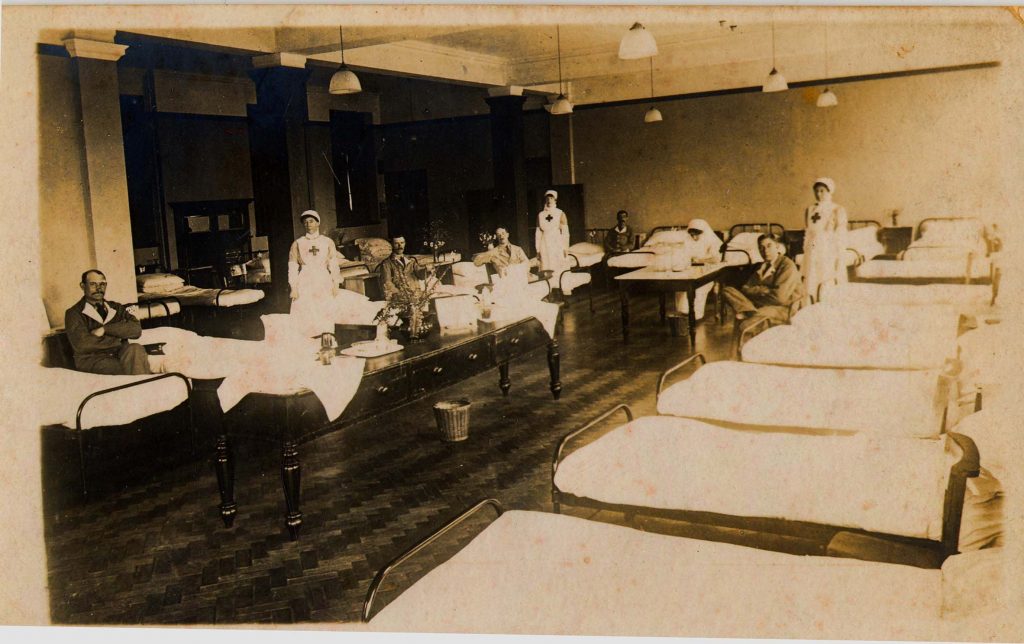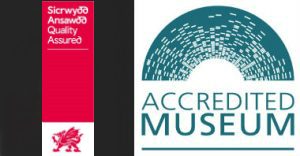Swansea Museum Collection

Black and white photograph and postcard showing an internal view of one of the wards at the converted Swansea YMCA taken circa 1918. Nurses and patients are clearly visible. Gelatine paper print.
The photograph is the gymnasium, (now Dojo) which is above the Llewelyn Hall Theatre. The new building opened in October 1913 and within a year the 1st WW has started.
There are a number of photographs by Chapman the High St photographer of patients and nurses at the hospital. It would appear that a few of his daughters were Red Cross volunteers and a son who was serving in the army, was a member of the YMCA.
An excellent book, Swansea in the Great War by Bernard Lewis has a detailed chapter on the medical provision in Swansea and contains another photograph by Chapman of the staff and patients on the roof of the building.
On the outbreak of war, the Swansea Red Cross Division began the search for suitable accommodation to convert to hospitals. Early in the search in October 1914 they looked at both Sketty Church Hall and Llewelyn Hall (the YMCA theatre).
Heavy casualties suffered by the British Expeditionary Force in the early months of the war hastened efforts to find suitable premises as hospitals would be required sooner rather than later. It was also becoming clear that more than three Red Cross Volunteer Aid Detachments (VADs) would be required.
VAD 88 was based at Llewellyn Hall and received their first patients on the 3rd December 1914. With increasing number of casualties Parc Wern was also opened in 1915.
The Red Cross continued to search for a suitable single building as casualties mounted. In the meantime a further ten beds were installed at the YMCA.
A special committee was appointed to look at a suggestion by Mrs Elswoth of the Red Cross that a hospital of eighty beds could be run if the whole of the YMCA was taken over. However as Parc Wern had recently opened the project to take over the whole of the YMCA was put to one side.
However by early 1917 with no end of the war in sight, a decision was taken to take over the building entirely. In May 1917 the hospital was fully ready with 140 beds. A year later it had received a total 658 patients as compared to 308 in the previous two years.
The YMCA moved out of the building and down St Helen’s Road to St Andrews Church, now Swansea Mosque.
During the 4 years it was open 1443 patients were treated there. This included 32 survivors from a hospital ship the Rewa who were landed at Swansea after being torpedoed in the Bristol Channel.
One of the nurses who worked at the YMCA hospital was Mary Morgan nee Corfield. An oral history interview was conducted with her in the 1980s and the tape is part of Swansea Museum Collection (oral history interview SM 1991.11.1.)
She describes how during the war the YMCA played an important support role providing soldiers with food and drink and paper and envelopes for writing. She trained as a nurse and then went to work at the YMCA where the shifts would be 6am till 2pm and then 6pm to 10pm. Most of the casualties were transferred by sea to Cardiff and then onto Swansea. Mary remembered that patients arrived with terrible injuries. Despite the terrible injuries Mary enjoyed her work as a nurse and would have liked to pursue a career in nursing. However her father put an end to her nursing career as soon as the war was over.
The YMCA Hospital was not for walking wounded or convalescence purposes. It is therefore quite remarkable that only one patient is recorded as dying there. A second casualty who died is unidentified but was a local man and therefore was allowed to go home. The one patient who died at the hospital was Lance Corporal Gordon Rankin Inglis, an Australian, wounded at Gallipoli.
At the end of March 1919, the hospital was closed and the building handed back to the YMCA. It was not the end of the relationship as the Red Cross rented a club room in the building in partnership with the Royal College of Nurses (RCN). This arrangement continued until the mid-1930s at which point they rented a room at 122 Walter Rd due to the unsatisfactory heating arrangements at the YMCA.

